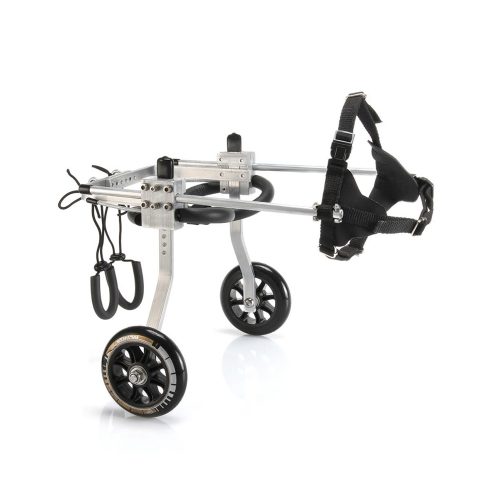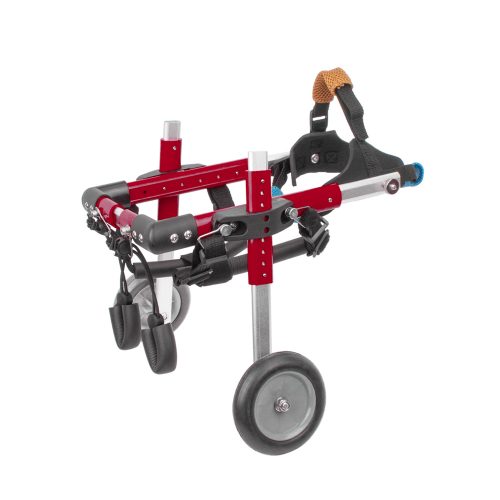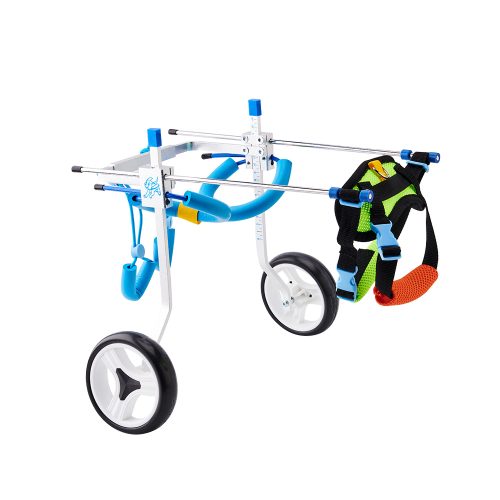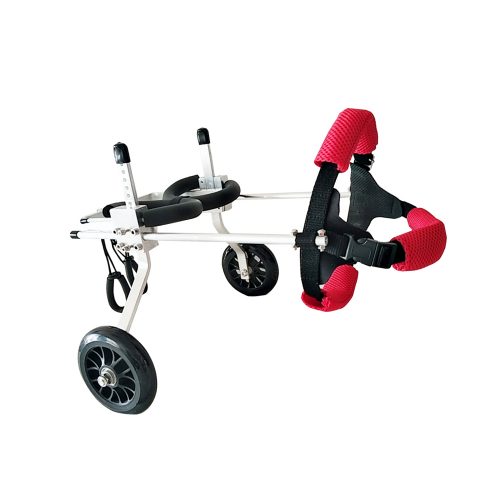BEST DOG WHEELCHAIR COLLECTION FOR YOU
Usually, there are three types to choose from full support dog wheelchair, rear support dog wheelchair, and dog wheelchair for front legs. Used dog wheelchairs are also available on the market.
- Towel Test
Is the dog able to move quickly using only its front limbs? If so, use a rear-supported canine wheelchair. If the dog cannot move with the front limbs, choose a full-body support wheelchair or a forelimb support wheelchair.
- Full support dog wheelchair
These wheelchairs are suitable for dogs with weakness in the hind and front limbs. Your dog is a candidate for this dog wheelchair if it has one of the following conditions.
Total body weakness
Trauma to the spine
Amputation of a limb
Arthritis
IVDD
Cerebellar hypoplasia
Intervertebral disc rupture
Degenerative bone marrow disease
Post-surgical support of the hip, disc, or knee joint
- Dog wheelchair for front legs
This dog wheelchair is suitable for dogs with forelimb dysfunction. Some eliminate up to 70% of the weight-bearing on the forelimbs.
Your dog is suitable for this dog wheelchair if he has one of the following conditions.
Total body weakness
Spinal trauma
amputation of a limb
Arthritis
Intervertebral disc disease (IVDD)
Cerebellar hypoplasia
Intervertebral disc rupture
Degenerative bone marrow disease
Post-surgical support of the hip, disc, or knee joint
- Rear support dog wheelchair
Hind limb wheelchairs are often beneficial for dogs with weak hind limbs but strong forelimbs. Your dog is a good candidate for this type of dog wheelchair if it has one of the following conditions.
Hip dysplasia
IVDD
Post-surgical rehab of the hip, spine, or knee
Hind limb amputation
Traumatic injury
Rupture of intervertebral disc
Degenerative bone marrow disease
generalized weakness
Arthritis
- Wheels
- Best Brands
K9 Carts
Best Friend Mobility
Walkin' Pets
SitGo
NeoAlly
Lsnisni
- DIY Dog Wheelchair Plan 1: PVC Pipe Dog Wheelchair
Moderate
2. Tools Needed:
- Saw
- Measuring tape
- Cordless drill
- Scissors
- Sewing needle
- Mallet
- Pen
3. Materials Required:
- PVC pipe (10 feet)
- PVC T connectors (2)
- PVC elbows (4 )
- Dolly wheels (2)
- C-clips (2)
- wheel axle
- Pool noodle
- Thread
- Ace bandages
- Epoxy adhesive
- DIY Dog Wheelchair Plan 2: 3D-Printed Dog Wheelchair
Moderate
2. Tools Required:
- Measuring tape
- 3D printer
- Saw
- Pen
3. Materials Needed:
- Rollerblade wheels
- Acrylic tubing
- Plastic for connector
- DIY Dog Wheelchair Plan 3: Aluminum Dog Wheelchair
Very difficult
2. Tools Required:
- Aluminum tube-bending tool
- Cordless drill
- Metal hacksaw
- Pen
- Measuring tape
3. Materials Needed:
- Aluminum tubes(5)
- Sponge tube
- Bike flashlight mounts (6)
- Two wheels
- Screws
- Velcro
- Aluminum tube plastic cap
- Sand/gravel
Firstly, you need to measure your dog's chest circumference.
Next, measure the rib cage.
Finally, please measure the width of the tiny bumps on the chest so that their nipples can poke out.
Step 2: Measure height
To measure height correctly, the dog should stand up straight. The back, legs, and chest should be naturally upright.
Step 3: Prepare the parts
Prepare all the parts before you start. Most front support dog wheelchairs tend to use the following components.
Bicycle torch holders (6)
Aluminum tube of the right dog size
Sponge tubes
Electric drill
Screw
AL tube plastic cover
Two wheels
Nylon buckle
Step 4: Cut the tubes
Once you have measured your dog, cut the aluminum tubes according to their dimensions.
Step 5: Drilling the holes
After bending the tube, drill holes in the tube.
Step 6: Assemble the wheelchair
Put the screws in the bracket of the bike torch. It has a piece of rubber that gives friction to the tube. This will allow you to tighten it down.
Step 7: Make an adjustable front handle
Drill holes in the tube of the front handle to fit the length of your dog. Get plastic to cover the aluminum tube.
Step 8: Finish
Get the nylon buckle through the sponge tube. Place it snugly on the back of the wheelchair. Adjust the tube to ensure the dog is comfortable.
If you have the time, you can make your dog wheelchair. Dog wheelchair rental is also available. You can also rent a used dog wheelchair.
It depends on your budget, the needs of your dog, and so on. When you see your dog running around, you will feel that it is worth the investment.
This is usually very easy to do. However, sometimes there is an adjustment period for dogs.
What mobility problems does a dog wheelchair help with?
Whether a dog can benefit from a wheelchair depends on the degree of disability. Dog wheelchairs can help with mobility problems, which include:
- Hip dysplasia
- Degenerative bone marrow disease
- Paralysis
- Spinal problems
- Weakness in limbs
- IVDD
- Neurological problem
- Surgical recovery
- Arthritis
- Amputation
Most dogs adapt quickly to life in a dog wheelchair. Some dogs may take longer to adapt and require your care.
1. Perfect fit
An uncomfortable wheelchair may make it difficult for a dog to adapt. Often, adjusting the wheelchair is all that is needed to make the dog comfortable.
2. A positive experience
You can reward your dog with treats and toys that he likes to walk forward. It is a good idea to train your dog when he is hungry.
3. Wear a harness
Once your dog is comfortable with the wheelchair, put the front harness on to get them used to it. Make sure the carrier is adjusted correctly. A well-fitting harness will be more comfortable!
4. Add the rest of the pieces
Once the dog has adapted to the carrier, try putting it on the dog wheelchair. Next, place the treats in front of the dog's nose. Encourage the dog with praise.
Open the front neck yoke.
Move the dog to the wheelchair's front.
Lift the hind legs and put them through the ring of the saddle.
Move the tail.
Make the dog stand up in the dog wheelchair.
Press the yoke back into place.
Tighten the chest support straps and buckle them on.




